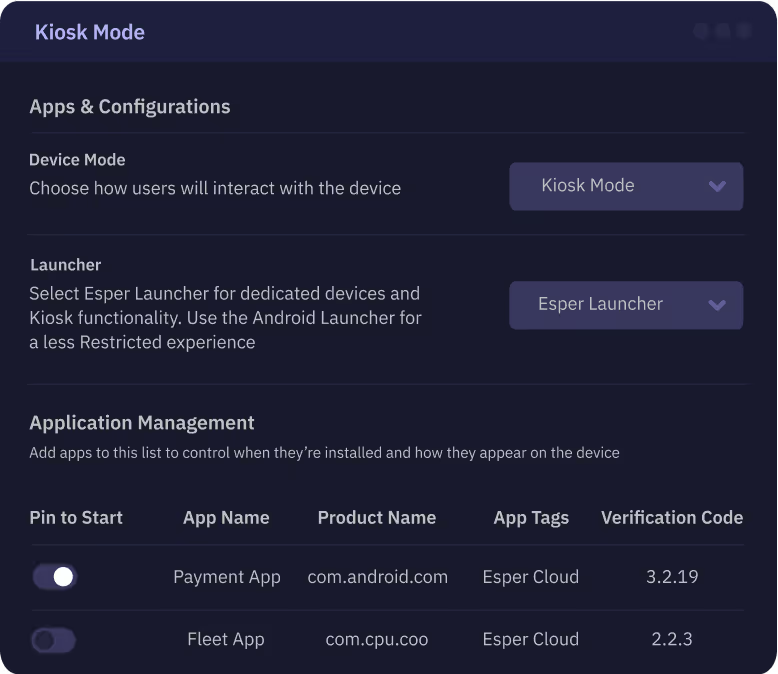
Geofencing is your automated sentry to prevent theft and maximize ROI
Asset theft is an unfortunate reality for modern businesses. But a device that locks down and alarms when it’s not where it’s supposed to be sends a clear message: You won’t make that theft easy. Protect your high-end kiosk hardware, sensitive patient records, or confidential business data with powerful geofencing.

While theft is the top concern for any device fleet operator, the value of strong geofencing goes beyond theft protection. Lost devices, assets straying from their defined zones, and misuse are common risks — and where geofencing provides proactive value, not just defensive insurance. Here’s how.






.avif)

Guarantee that every user has the exact experience you want — nothing more, nothing less.

Fully lock down devices to prevent misconfiguration and other tinkering that leads to costly troubleshooting and maintenance.

Limit devices to essential functions, eliminating employee distractions and customer confusion.

Shield devices from unauthorized access and modifications, keeping sensitive company data safe.

Purpose-built devices have a job to do. From point of sale systems to digital kiosks, Android to iOS, these devices are central to modern business interactions and revenue generation. When they deviate from their intended function, operations grind to a halt, causing customer frustration and lost revenue.

Don’t let an unsophisticated kiosk feature bring down your business. Esper’s hardened kiosk mode can’t be bypassed, offering robust protection for valuable hardware assets while ensuring every device in your fleet is always doing what it’s supposed to.

You can’t watch your devices 24/7 — but with Esper, you don’t have to. From high-value retail kiosks to classroom tablets, lost or stolen devices are no longer a constant worry. Esper’s geofencing provides the peace of mind that your assets are secure, day and night.
From the moment you set up geofencing, your devices gain an added layer of protection, allowing you to focus on what matters most: running your business.

BusRight and Esper both value simplicity, usability, and an outstanding user experience, so it’s a natural partnership. After Esper’s free trial, we became so accustomed to their modern and intuitive platform, the competitor solutions just felt off. Also, the features that Esper provides are robust where other companies say they provide the same solutions, but they’re clearly not built for fleet management.



In order to cope with the Pandemic and ensure that our students wouldn’t miss out or fall behind, we procured 10,000 devices with an aim to use them for blended learning once the schools resumed. A Mobile Device Manager (MDM) wasn’t enough. We required a partner that would help us to restrict usage to educational apps, track our devices and enable our teachers to monitor the students’ usage of the devices.



BusRight and Esper both value simplicity, usability, and an outstanding user experience, so it’s a natural partnership. After Esper’s free trial, we became so accustomed to their modern and intuitive platform, the competitor solutions just felt off. Also, the features that Esper provides are robust where other companies say they provide the same solutions, but they’re clearly not built for fleet management.


In order to cope with the Pandemic and ensure that our students wouldn’t miss out or fall behind, we procured 10,000 devices with an aim to use them for blended learning once the schools resumed. A Mobile Device Manager (MDM) wasn’t enough. We required a partner that would help us to restrict usage to educational apps, track our devices and enable our teachers to monitor the students’ usage of the devices.

Geofencing creates a digitally fenced area that triggers an action when a device enters or leaves that area.
A common example of geofencing is location-based marketing in smartphone apps. When you get within the vicinity of a store, the app may generate a notification telling you about local deals or encourage you to use their store assistance mode. In this scenario, the geofenced area triggers when you enter it. In others, the geofence triggers when the device leaves it.
Yes. This isn’t a native function of any operating system (mobile or otherwise) and requires third-party software.
App pinning needs to be enabled in Settings. After that, you can swipe up to show recent apps, long press on the app, and select Pin. For more information, check out our full guide on how to use app pinning.
Geofencing is as accurate as the GPS on the device. This will vary by location — very dense areas (with trees or buildings, for example) will be less accurate than open areas.
Yes! It isn’t a native function, but you can enable geofencing with third-party software.